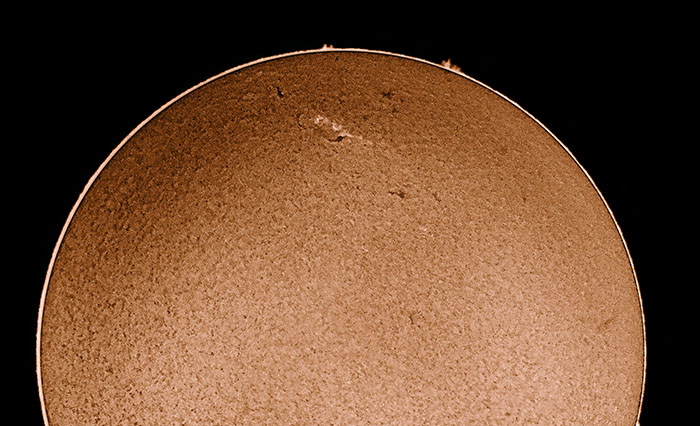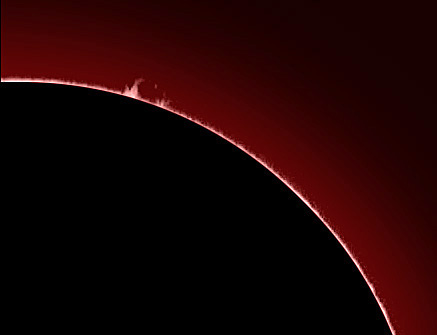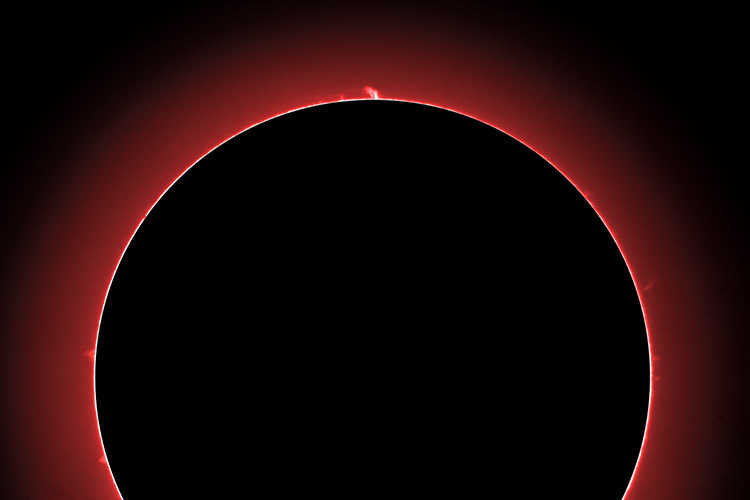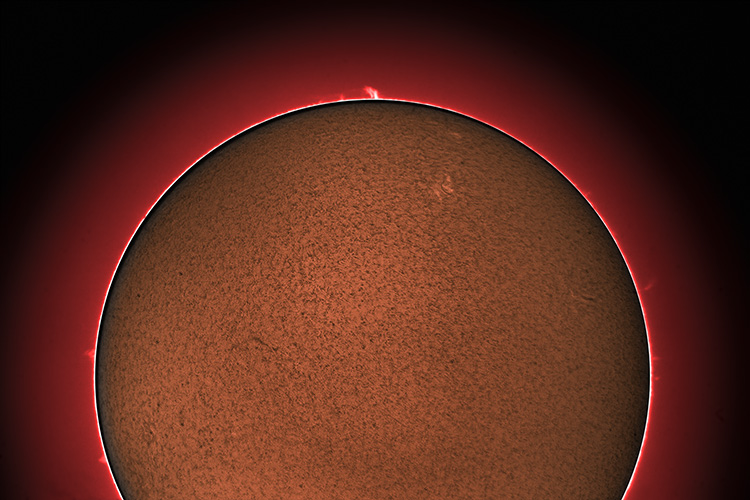|
Staring at the Sun, 5 :: home :: |
|
6/22/2010. No photos worth showing off today. But here are a few lessons that need to get posted when there is next any news worth sharing:
Same scale as
previous images, cropped. 1/8 second, ISO 400.
6/23/2010. As feared, the 90mm Losmandy mounting rings are too small for the solar 'scope's tube. They're also too small for the ST80 guide scope. But they're just right for that brass tube I've been slowly outfitting to rebuild a 3-inch Unitron. They attach via 10-24 machine screws to a mounting plate to be provided by the user. So now I know how I will attach the rebuilt Unitron to its mount (I finally have some ideas about how to repair the polar axle that snapped in shipping a Unitron equatorial home from New Mexico Skies ten years ago). In other solar news: under today's much clearer skies, I confirmed that the 10.5mm TeleVue Plossl gives a nice view of the Sun (I begin to wonder if there is any eyepiece that doesn't). It's a good middle ground between the small but immaculate image in the 20mm Plossl and the detailed but dim image in the 7mm Nagler. Under clearer skies, the 10.5 provided a lovely scale and excellent detail when focusing the 50D with Liveview. Even so, I've yet to get even one decent image from that configuration. The exposure needs to be about 1/4 second at ISO400 (1/20 at 2000 works better for detail, but noise is lethal). The results are terribly fuzzy no matter what I've tried. This image scale may simply be asking too much of the 50mm aperture. I would be more certain of that except that I've seen exquisite images online from the 50mm front filter. It seems that a webcam or a monochrome video camera may be required for close and detailed views; there is still some hope that a better, more refined technique will do. When using the stock Crayford focuser for critical focusing of a heavy and somewhat cumbersome image train, you must carefuly adjust both the lock screw and the tensioning screw. Today I added a couple of moderately stretched rubber bands to take on some of the weight of the Canon and eyepiece projection adapter. The elastic bands allowed both the coarse and fine focus knobs to lift the load vertically (the Sun was nearly overhead).
6/24/2010. I tried several versions of webcam capture software this morning (Iris, Debut, WxAstro Capture, and 2 versions of K3CCD). I was looking for a combination that would allow my Philips Vesta Pro to capture AVI's that will work gracefully with Registax (either v2 or v5.1). "Gracefully" means without my having to hunt and load a specific codex. In the end, I got the most satisfaction out of the freeware version of K3CCD Tools and I remain undecided between the simpler, early (2003) Registax or the more complex and capable current edition (v5.1). What I have not got yet is a decent image of disk detail. Just as I got a kit together to try for that, heat shut down the power supply again (I forgot to shade it while concentrating instead on shading me and the computer screen). S'OK: I captured several 10 second drifts of the Sun across the chip and had great fun watching Registax lock onto a prominence and align and stack the moving image. Thus, 100 frames at 10 frames per second, 1/50 second each, aligned and stacked:
That doesn't seem like an improvement over what I can get with the DSLR. I could see projected disk detail on the computer screen, and single frame snapshots confirm that the webcam can capture it. Carefully adjusted clips (45MB each!) show some disk features, but none of the video clips reveal as much detail as I could easily see, still less do they capture the wealth of hidden detail I hope to get from stacked frames. About 4:30, I found surprisingly steady air, so I tried a few frames with the 50D and extended barlow (that is, the barlow but no eyepiece in the eyepiece projection extension). I was actually trying for disk detail with the stacked filters, but the best of the bunch was this longer exposure of limb detail:
Canon 50D,
1/4 second, ISO 400, single etalon.
I extracted the red Bayer plane using Maxim DL5 from two consecutive 1/4 second exposures. A surprising amount of disk detail showed up. I saved them as 16-bit TIF files, overlayed them in Photoshop to reduce grain, and then went to work to extract good tones and detail from the disk. Finally, I laid the finished disk image back on the prominence image above. So here is a composite from two 1/4 second frames, merely treated differently to get edge and disk detail:
Click the image for wallpaper.
Focusing may not be everything, but it's a lot.
|
:: top ::
© 2010, David Cortner



